생후 15~18개월 유아들의 성장 발육, Growth and development of 15~18 month old toddlers
생후15~18개월 유아들의 성장
- 유아의 체중과 신장을 재서 성장차트 백분위선에 그려본다.
- 유아의 체중 치와 신장치가 성장차트 체중·신장 백분위선 상 어디에 있는지 알아본다.
표 3-22. 15개월 유아들의 체중과 신장의 백분위수
|
백분위 수
성별 |
3 | 10 | 25 | 50 | 75 | 90 | 97 | |
| 남아 | 체중(kg) | 7.70 | 8.50 | 9.30 | 10.00 | 10.80 | 12.00 | 12.80 |
| 남아신장(cm) | 70.6 | 74.0 | 76.0 | 78.5 | 80.5 | 83.00 | 88.6 | |
| 여아 | 체중(kg) | 7.50 | 8.0 | 8.80 | 9.50 | 10.50 | 11.30 | 12.50 |
| 여아신장(cm) | 68.2 | 72.4 | 74.6 | 76.8 | 79.0 | 81.3 | 85.0 |
- 체중과 신장이 과거 성장차트 체중·신장 백분위선을 따라 이전 성장속도와 같이 계속 정상적으로 잘 자라는지 알아본다.
- 이 시기의 대부분의 유아들의 체중과 신장의 성장 속도는 이전의 성장 속도에 비해 좀 느린 것이 보통이다.
- 이 시기의 대부분의 유아들의 성장 속도가 정상적으로 느리고 서서히 자람에 따라 먹는 음식물의 섭취량도 그에 따라 많지 않고 먹성도 시원치 않은 것이 보통이다.
- 부모들의 생각으로 이 시기 유아들은 거의 자라지 않는 것 같지만 6~12개월 간격을 두고 체중과 신장을 재고 그 잰 체중 치와 신장 치를 성장차트 체중·신장 백분위선에 그려보면 전과 거의 같은 성장 속도로 정상적으로 계속 자라는 것을 알 수 있다.
- 1세에서 사춘기가 시작되기 바로 전까지 대부분의 유아들과 학령기 아이들의 체중과 신장의 성장 속도가 정상적으로 느릴 수 있다.
- 사춘기가 시작된 이후부터 사춘기 기간 동안 학령기 아이들과 사춘기 아이들의 체중과 신장의 성장 속도는 정상적으로 아주 빠르다.
- 때로는 굉장히 빠른 속도로 자란다.
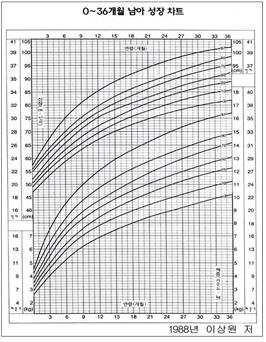
그림 3-130. 생후 0~36개월 된 한국 남 신생아들과 남 영유아들의 성장차트와 백분위수.
Copyright ⓒ 2012 John Sangwon Lee, MD., FAAP
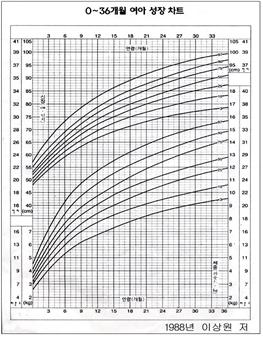
그림 3-131. 생후 0~36개월 된 한국 여 신생아들과 여 영유아들의 성장차트와 백분위수.
Copyright ⓒ 2012 John Sangwon Lee, MD ., FAAP
| 생후 15~18개월 유아들의 발육 |
1. 생후 15~18개월 유아들의 신체 발육
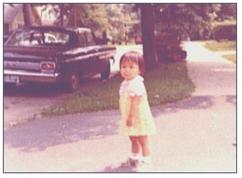
사진 3-132. 이 나이 유아들의 대부분은 혼자서 잘 걸을 수 있다. 교통사고나 다른 종류의 안전사고가 나지 않게 주의한다.
Copyright ⓒ 2012 John Sangwon Lee, MD., FAAP
- 이 시기의 대부분의 유아들의 성장 속도가 정상적으로 느려서 언뜻 보기에 잘 자라지 않는 것 같다.
- 그러나 그들의 체중과 신장은 그들의 성장차트 체중·신장 백분위선을 따라 정상적으로 서서히 매일 성장하고 있다.
- 이렇게 체중과 신장은 서서히 성장하지만 발육 속도는 이전보다 아주 빠르다.
- 그들은 육체적으로 아주 활동적이어서 안전사고가 나기 쉽다.
- 그들의 일거일동을 항상 보살펴 안전사고가 나지 않게 예방해야 한다.
- 이 시기의 대부분의 유아들이 걸을 때 전보다 더 꼿꼿한 몸자세를 취하고 양발은 평행되게 앞으로 걸을 수 있다.
- 배를 앞으로 좀 불쑥 내밀고 걷는 것이 보통이다.
- 어디든지 기어 올라갔다 내려갔다 하면서 놀기 좋아한다.
- 떨어져 다치기가 쉽다.
- 위험한 곳에 올라가지 않도록 주의한다.
- 이 시기의 유아들이 위험한 곳에 가려고 떼 쓸 때 그들에게 가지 말라고 말로만 하면 그들은 가서는 안 되는 이유를 아직 잘 이해할 수 없다. 그래서 가지 말라고 말로 교육시키는 대신 아예 안전한 곳으로 유아를 데리고 가서 거기서 안전하게 놀게 한다.
- 이 시기의 대부분의 유아들은 부모나 다른 사람의 도움이 없이 계단을 혼자 걸어 올라갈 수 있고 계단을 뒤로 기어 내려갈 수 있다.
2. 생후 15~18개월 유아들의 손 발육
- 이 시기의 일부의 유아들은 공을 앞으로 던질 수 있고 앞으로 던진 공이 자기에게 되돌아올 곳을 예상하고 그 돌아올 것이라고 예상하는 곳에 가서 돌아오는 공을 잡을 준비를 할 수 있다.
- 두 개의 정육면체 블록을 아래위로 포개어 탑을 쌓을 수 있다.
- 콩알이나 그와 같이 작은 장난감 등을 엄지손가락과 인지로 집어 병 속에 넣을 수 있다.
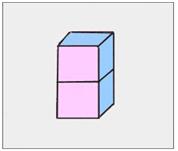
그림 3-133. 생후 12~20개월 된 유아들의 대부분은 두 개의 정육면체 블록을 아래위로 포개어 탑을 쌓을 수 있다.
Copyright ⓒ 2012 John Sangwon Lee, MD., FAAP
3. 생후 15~18개월 유아들의 언어 발육
- 부모나 식구도 확실히 이해할 수 없는 아기 말로 몸짓 말로 자기의 의사를 표현할 수 있다.
- 이 시기의 유아들은 ‘응’ ‘저기’ 또는 ‘아니’ 등의 단어를 자주 쓸 수 있고 매일 새 단어를 배우고 적어도 세 개 이상 의미 있는 단어를 합쳐 말할 수 있다.
4. 생후 15~18개월 유아들의 사회성 발육
- 집 밖에서 놀기를 좋아한다.
- 집안에서는 이 방에서 저 방으로 돌아다니면서 놀 수 있고 쓰레기통 속 쓰레기를 꺼냈다가 집어넣고 놀기를 좋아한다.
- 음악의 리듬에 맞춰 춤추기도 하고 혼자서나, 또는 엄마아빠와 같이 그림책을 보기 좋아한다.
- 간단한 심부름을 할 수 있다.
- 심부름을 시키면 때로는 듣지 않고 심부름을 수행하지 않는다.
- 이 시기 어떤 유아들은 어디를 갈 때 특별히 좋아하는 “과도기 물체(일시적 대상/이행기대상, Transitional objects)-장난감, 인형 또는 담요 등을 가지고 다닌다.
- 바퀴 달린 장난감을 끌고 밀면서 놀기를 좋아한다.
- “생후 1개월~6세의 영유아들의 발육 이정표” 참조.
이런 경우는 영유아 발육지연을 의심해본다 참조
| 생후 15~18개월 유아들의 장난감 |
장난감 참조
| 생후 15~18개월 유아들의 영양 |
- ‘저렇게 조금씩 먹고 어떻게 자랄 수 있을까’ 걱정을 할 정도로 음식물을 조금씩 먹는 유아들도 있다.
- 생후 9개월부터 사춘기가 시작될 때까지 체중 성장 속도가 정상적으로 느리고 먹는 음식물 양도 성장 속도에 비례해서 시원치 않은 것이 보통이다.
- 이때부터 모유수유를 하는 것, 인공영양을 먹이는 것을 일반적으로 권장하지 않는다.
- 가능하면 밥상 음식물을 주식으로 하루 세 번 먹게 한다.
- 특별히 좋아하는 음식물을 주식과 주식 사이에 간식으로 하루 두 번 정도 주어도 된다.
- 이 시기의 대부분의 유아들은 음식물을 전보다 덜 흘리고 깨끗이 먹을 수 있다.
- 그러나 부모가 계속 보살펴 먹여야 한다.
- 의자에 혼자 따로 앉아 식탁에 차려놓은 음식물을 스스로 먹기도 하고 다 먹은 후 빈 그릇을 엄마에게 갖다 줄 수도 있다.
| 생후 15~18개월 유아들의 양호 |
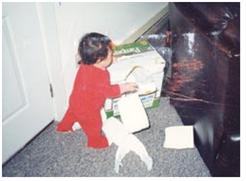
사진 3-134. 안전사고가 나지 않게 극히 조심한다.
Copyright ⓒ 2012 John Sangwon Lee, MD,, FAAP
- 1일 총 밤에 잠을 자는 시간이 전에 비해서 점점 더 짧아진다([부모도 반의사가 되어야 한다-소아가정간호백과]-제 22권 아들 딸 이렇게 키우시오-정상 잠 패턴 참조).
- 캄캄한 방에서 혼자 자기 싫어하고 자다가 자주 깰 수 있다.
- 이때부터 낮잠을 거의 자지 않는 유아들도 있다.
- 대부분의 유아들은 밤낮에 대소변을 아직 가리지 못한다.
- 그렇지만 대소변 가리기 연습을 꾸준히 해야 한다. 추락사고, 화상사고, 독극물 중독사고, 약물 또는 화학물질 중독사고, 익사 사고나 교통사고 등 안전사고가 나지 않게 잘 예방해야 한다.
- 생후 15개월경 정기 건강검진을 받고 생후 12~15개월에 1차 MMR(홍역 볼거리 풍진 백신)백신 예방접종을 받는다.
- 4차 B형 헤모필러스 인플루엔자 박테리아 전염병 백신(Hib Vaccine)을 생후 12~15개월에 받을 수 있다.
- 히브(Hㅑb) 예방접종 백신의 종류에 따라 접종 횟수와 접종받을 수 있는 연령이 다르다.
- 4차 DTaP는 생후15~18개월경에 받는다.
- 3차 불활성 소아마비 예방접종(IPV) 백신을 생후 6~ 18개월에 받을 수 있다.
- 3차 B형 간염예방접종 백신을 생후 6~18개월에 받을 수 있다.
- 4차 폐렴 연쇄상 구균에 의한 전염병 예방접종(PCV) 백신을 12~15개월에 접종 받을 수 있고
- 인플루엔자(Influenza) 예방접종 백신은 생후 6개월부터 매년마다 받는다.
- 2차 A형 간염(HepA) 백신 예방접종을 생후 12~23개월에 받을 수 있다.
- 예방접종의 횟수, 간격은 예방접종 백신의 종류에 따라 다르고, 접종받는 년도, 각 나라에 따라 다르게 권장한다.
- 단골 소아청소년과나 사는 지방의 보건소 등에 문의해 예방접종을 받을 수 있다.
- 지금까지 적어도 DTaP 예방접종, 불활성 소아마비 예방접종, B형 간염 예방접종, B형 헤모필러스 인플루엔자 박테리아에 의한 전염병을 예방하기 위해 히브 예방접종, 수두 예방접종, 폐렴을 예방하기 위해 폐렴 예방접종을 권장한 대로 접종받지 않았으면 이때 따라잡기 예방접종을 모두 받는다.
- ProQuad 백신이나 Pediarix 백신 등 종합 예방접종 백신으로 접종해 받을 수 있다.
- 필요에 따라 납중독 혈액 검사, 빈혈 검사, 소변검사 등을 받을 수 있다.
- 다음 정기 건강검진은 생후 18개월경에 한다( 표2-11 예방접종표 1 참조).
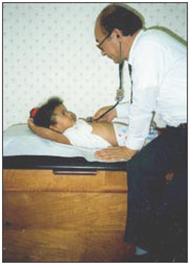
사진 3-135. 다음 정기 건강검진을 생후 15개월경에 하고 필요한 예방접종을 한다.
Copyright ⓒ 2012 John Sangwon Lee, MD., FAAP
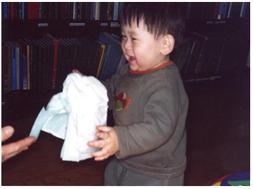
사진 3-136. 조건 없고 진정한 사랑을 충분히 받고 자라는 아이들은 남을 돕는 것을 좋아한다. 부모의 말을 잘 듣고 부모의 훈련에 잘 순응한다. Copyright ⓒ 2012 John Sangwon Lee, MD., FAAP
|
다음은“17개월 아이의 체중이 늘지 않습니다. 성장 발육”에 관한 인터넷 소아청소년 건강상담 질의응답의 예 입니다. |
Q&A. 17개월 아이의 체중이 늘지 않습니다. 성장 발육.
Q
안녕하세요? 지난번에 선생님께 질문을 드렸었는데 선생님께서 바쁘신 중에도 친절히 상담해 주셔서 감사했습니다.
제 아이는 지금 17개월 된 남자 아이인데요, 태어날 때 체중이 2.88Kg, 키는 47.4cm 이었습니다. 아이는 태어나서 모유를 백일 정도까지 먹이기는 했는데 젖양이 작았는지 한 번 물면 1시간 ~2시간은 물고 있었습니다. 그래서 젖은 하루에 2회 정도 먹이고 (먹은 양은 거의 없었던 것 같습니다.) 대부분 분유로 대신했습니다. 이유식은 6개월경부터 시작은 했는데 제대로 먹기 시작한 건 돌 지나서부터 입니다. 아이가 태어날 때부터 체중이 적게 나가긴 했지만 돌 무렵에는 10.9Kg (출생 시의 3.8배) 까지 나가 별 걱정을 안했는데 돌이후로 체중이 늘었다 줄었다 하더니 지금은 17개월인데도 체중이 11 Kg밖에 나가질 않습니다. 돌때 키가 74.5cm 이었는데 지금은 5cm 더 자라서 80cm입니다. 5개월간 몸무게가 거의 늘지 않아 너무 걱정이 됩니다.
참고로 저희 아이는 아침에 8시쯤 눈떠서 낮잠을 3시간 자는 것 빼고는 밥 12시에 잘 때까지 활발하게 아주 잘 놀고 밥은 하루 2번(밥, 고기야채국, 고기산적, 치즈), 우유(페디아슈어)2~3회 (총 400~500ml), 토마토 1개, 과자 등을 먹습니다. 답변 기다리겠습니다. 감사합니다.
A.
- 은원님 안녕하세요.
- 갑자기 가정 사정으로 인해 전화도 인터넷도 TV도 없는 곳에 갔다가 이제 돌아와서 질문에 답변을 드리오니 관대히 양해 해 주시기 바랍니다.
- 질문해 주셔서 감사합니다.
- 좋은 질문입니다.
- 자녀의 나이, 성별, 과거 병력, 가족 병력, 진찰소견, 임상검사 등의 정보를 많이 알수록 답변을 드리는데 도움이 됩니다.
- 주신 정보를 토대로 해서 답변을 드리겠습니다.
- 출생 시 체중은 5 퍼센타일, 신장은 5 퍼센타일, 생후 12개월 때 체중은 90 퍼센타일, 신장은 50퍼센타일, 생후 17개월 때 체중은 75 퍼센타일, 신장은 50 퍼센타일 이군요(이상원 한국 소아 성장차트에 의하면), 이미 성장차트에 그려보셨겠지만 신장과 체중의 성장이 예측하기 곤란할 정도입니다.
- 무슨 이유로 아기가 출생했을 때 저 체중신생아이었고 그 동안 성장상태를 보면 신장은 50퍼센타일로 계속 자랐고 18세가 되면 키가 170cm 정도가 예측되고 체중은 75~90퍼센타일로 자랐고 이런 식으로 계속 자란다면 18세에 체중이 적어도 63~65kg 정도가 될 것입니다.
- 지금은 17개월인데도 체중이 11 Kg밖에 나가질 않습니다. 돌때 키가 74.5cm 이었는데 지
- 그런데 먹는 것을 살펴보면 우유, 치즈, 페디아슈어 등으로 그날 필요로 하는 칼로리 양과 수분 양 그리고 영양분을 거의 다 충분히 섭취하고 있는 것 같습니다.
- 이런 경우 자연적으로 다른 음식물을 잘 먹지 않게 됩니다.
- 첫 돌 이후부터 사춘기가 시작될 때까지 성장속도가 정상적으로 느립니다.
- 성장차트 체중·신장 백분위선에 아기의 체중 치와 신장 치를 그려보시고 아기의 고유한 성장 속도에 따라 아기가 자라는지 그려보십시오.
- 지금 아기는 좀 통통하게 살찐 아기일 것입니다.
- 아마도 아기는 아기의 고유의 체중 신장 속도를 정상적으로 체중이 늘고 키가 크는 것같이 보입니다.
- 18개월에 소아청소년과에서 정기 건강검진을 받으시고 이 문제에 대해서 상담하시기 바랍니다.
- 해당 연령 성장 발육, 생후 1개월~6세 아이들의 발육 이정표. [부모도 반의사가 되어야 한다– 소아가정간호 백과]-제 14권 소아청소년 내분비, 유전, 염색체, 대사, 희귀병–성장차트 등을 참조하시기 바랍니다. 질문이 더 있으면 다시 연락해 주시기 바랍니다. 감사합니다. 이상원 드림
- 자녀사랑 참조
Growth and development of 15-18-month-old toddlers
Growth of infants aged 15 to 18 months
• Measure the weight and height and draw it on the percentile line of the growth chart.
• Find out where the weight and height are on the growth chart’s weight and height percentiles.
Table 3-22. Percentiles of weight and height for 15-month-old toddler’s percentile
표 3-22. 15개월 유아들의 체중과 신장의 백분위수
|
percentile
Gender |
3 | 10 | 25 | 50 | 75 | 90 | 97 | |
| boy | weight (kg) | 7.70 | 8.50 | 9.30 | 10.00 | 10.80 | 12.00 | 12.80 |
| height (cm) | 70.6 | 74.0 | 76.0 | 78.5 | 80.5 | 83.00 | 88.6 | |
| girl | weight (kg) | 7.50 | 8.0 | 8.80 | 9.50 | 10.50 | 11.30 | 12.50 |
| height (cm) | 68.2 | 72.4 | 74.6 | 76.8 | 79.0 | 81.3 | 85.0 |
Find out if their weight and height continue to grow normally at the same rate as the previous growth rate along with the weight and height percentiles of the paste growth chart.
• The growth rate of most toddlers at this age in weight and height is usually slower than the previous growth rate.
• Most of the toddlers at this age grow normally slowly and slowly, so the amount of food they eat is not large and it is common that they do not eat well.
• In the opinion of parents, toddlers at this age hardly seem to grow, but if you measure their weight and height at intervals of 6 to 12 months and draw the measured weight and height values on the weight and height percentiles of the growth chart, they will grow at the same rate as before parents can see it continues to grow.
• From age 1 to just before the onset of puberty, most toddlers, preschoolers and school-age children may experience normally slow growth in weight and height.
• From the onset of puberty to the period of puberty, the rate of growth in weight and height of school-aged children and adolescents is normally very rapid.
• Sometimes it grows very fast.

Figure 3-130. Growth charts and percentiles of Korean male newborns, male infants and toddlers aged 0 to 36 months of age. Copyright ⓒ 2012 John Sangwon Lee, MD., FAAP

Figure 3-131. Growth charts and percentiles of Korean newborns, female infants and female toddlers aged 0 to 36 months of age. Copyright ⓒ 2012 John Sangwon Lee, MD ., FAAP
Development oft toddlers 15 to 18 months of age
1. Physical development of toddlers aged 15 to 18 months

Picture 3-132. Most children of this age can walk well on their own. Be careful not to cause traffic accidents or other types of safety accidents. Copyright ⓒ 2012 John Sangwon Lee, MD., FAAP
• Most toddlers at this age do not grow well at first glance because their growth rate is normally slow.
• However, their weight and height are growing normally, slowly, every day following the weight and height percentiles of their growth chart.
• The weight and height grow slowly, but the growth rate is much faster than before.
• They are very physically active and are prone to accidents.
• Always take care of their every move to prevent safety accidents.
• Most toddlers at this age are more upright than before when walking and can walk forward with both feet parallel.
• It is normal to walk with the stomach protruding forward a bit.
• Likes to play, crawl up and down everywhere.
• Easy to fall and get hurt.
• Be careful not to climb into dangerous places.
• When toddlers at this age are trying to go to a dangerous place, they just don’t quite understand why they shouldn’t go if they just tell them not to go. So, instead of verbally telling them not to go, parents take them to a safe place and let them play safely there.
• Most toddler children at this age are able to climb stairs on their own and crawl back downstairs without the help of a parent or other person.
2. Hand development of toddlers aged 15 to 18 months
• Some toddler children at this age can toss a ball forward, anticipate where it will return to them, and then go where they expect it to return and prepare to catch it.
• Toddlers can stack two cube blocks on top of each other to build a tower.
• Toddler can pick up a pea or small toy with your thumb and forefinger and place it in the bottle.

Figure 3-133. Most toddlers 12 to 20 months old can build a tower by stacking two cube blocks on top of each other. Copyright ⓒ 2012 John Sangwon Lee, MD., FAAP
3. Language development of 15-18 months old toddlers
• Able to use body language to express ideas in baby language that neither parents nor family members can clearly understand.
• Toddlers at this age can use words such as ‘yes’, ‘there’ or ‘no’ frequently, learn new words every day, and combine at least three meaningful words.
4. Social development of toddlers aged 15 to 18 months
• Likes to play outside the house.
• In the house, toddlers can play around from room to room, and toddlers like to take out and put garbage in the trash can and play with it.
• I like to dance to the rhythm of the music and read picture books alone or with mom and dad.
• Can run simple errands.
• When toddlers run an errand, sometimes they do not listen and do not perform the errand.
• At this age, some toddlers take their favorite “transitional objects”-toys, dolls, or blankets with them wherever they go.
• Likes to drag and push toys on wheels.
• See “Developmental Milestones for Infants 1 Month to 6 Years Old”. In this case, suspect the developmental delay in infants and young children.
Toys for toddlers 15-18 months old- toy reference
Nutrition for toddlers 15 to 18 months of age
• Some toddlers eat so little that they worry, ‘how can they grow up by eating so little?’
• From 9 months of age to the onset of puberty, weight growth is normally slow, and the amount of food eaten is usually not proportional to the growth rate.
• From this point on, breastfeeding and artificial nutrition are generally not recommended.
• If possible, try to eat three meals a day as a staple food.
• You may give your favorite food twice a day as a snack between stocks.
• Most infants at this age can eat clean and spill less food than before.
• However, parents must continue to take care of them.
•Toddlers can sit alone in a chair and eat the food set on the table by themselves, or they can bring the empty bowl to their mother after you’ve finished eating.
Good care and parenting for toddlers aged 15-18 months

Picture 3-134. Be very careful to avoid accidents. Copyright ⓒ 2012 John Sangwon Lee, MD, FAAP
• The total amount of sleep per night is getting shorter and shorter than before ([Parents should also become at least the half -doctors – Encyclopedia of Pediatric and Family Nursing]-Vol.
• Most of the toddlers hate sleeping alone in a dark room and I can wake up frequently.
• From this point on, some toddlers rarely take naps.
• Most infants are not yet having toilet training during the day or night.
• However, parents should continue to practice toilet training.
Safety accidents such as falls, burn accidents, poison poisoning accidents, drug or chemical poisoning accidents, drowning accidents, or traffic accidents should be well prevented.
• Get regular health check-ups around 15 months of age and receive the 1st MMR (Measles, Mumps, and rubella vaccine) vaccine at 12-15 months of age.
• Quaternary Haemophilus Influenza Bacterial Infectious Disease Vaccine (Hib Vaccine) is available at 12-15 months of age.
• The 3rd or 4th Hib vaccination can be given. But the number of vaccinations and the age at which they can be vaccinated differ depending on the type of vaccine.
• The 4th DTaP is given around 15-18 months of age.
• The third inactive polio immunization (IPV) vaccine is available at 6 to 18 months of age.
• The third hepatitis B vaccine is available at 6-18 months of age.
• Pneumococcal Streptococcus Vaccine (PCV13) vaccine is available at 12 to 15 months of age;
• Influenza vaccine is given every year starting at 6 months of age.
• The second hepatitis A (HepA) vaccine is available at 12 to 23 months of age.
• The frequency and interval of vaccination differ depending on the type of vaccine, and it is recommended differently depending on the year of vaccination and each country.
• You can get vaccinations by contacting your regular Pediatric clinic or the local public health center where you live.
• To date, at least DTaP vaccination, inactivated polio vaccination, hepatitis B vaccination, HIV vaccination to prevent communicable diseases caused by Haemophilus influenzae bacteria, varicella vaccination, and pneumonia vaccination to prevent pneumonia. Receive all catch-up immunizations at this time if not vaccinated as recommended.
• You can get vaccinated as a combined vaccine such as the ProQuad vaccine or Pediarix vaccine.
• If necessary, blood tests for lead poisoning, anemia tests, and urine tests may be performed.
• The next regular health checkup should be done around 18 months of age (refer to Table 2-11, Vaccination Table 1).

Picture 3-135. The next regular health checkup should be done around 15 months of age and necessary vaccinations should be given. Copyright ⓒ 2012 John Sangwon Lee, MD., FAAP

Picture 3-136. Children who grow up receiving enough unconditional and genuine love like to help others. Listen carefully to parents and adapt well to parental training. Copyright ⓒ 2012 John Sangwon Lee, MD., FAAP
Next, “My 17-month-old does not gain weight. This is an example of Q&A of Internet Children’s and Adolescent Health Counseling about “growth and development”.
Q&A.
A 17-month-old baby does not gain weight. growth development.
Q
Good morning? Last time, I asked the teacher a question, and I was grateful for the kind advice from the teacher even though he was busy.
My child is a 17-month-old boy now, and he weighed 2.88Kg at birth and was 47.4cm tall. He was breastfeeding for up to 100 days after the baby was born, but he was biting for an hour or two when he asked if the amount of milk was small. So he fed them wet twice a day (I think he ate very little), and mostly formula instead.
Weaning food started around 6 months, but I started eating properly after I passed the stone. Although the baby weighed less since birth, by the time she was born, she weighed up to 10.9Kg (3.8 times her birth weight), so I wasn’t worried.
When he was born he was 74.5 cm tall and now he has grown 5 cm to 80 cm. I have barely gained any weight in 5 months, so I am very worried.
For reference, my child wakes up around 8 in the morning and takes a nap for 3 hours, except for a 3-hour nap, he actively plays until he goes to bed at 12 o’clock and eats rice twice a day (rice, meat and vegetable soup, meat bandits, cheese), milk ( Pediasure) 2~3 times (total 400~500ml), eat 1 tomato, sweets, etc. Answers I’ll wait. Thank you.
A.
• Hello Eunwon.
• I suddenly went to a place where there was no phone, Internet, or TV due to family circumstances, and now I am back to answer your questions. Thank you for your patience. • Thank you for your question.
• Good question.
• The more information you have, such as your child’s age, gender, past medical history, family history, examination findings, and clinical tests, the more helpful it is to give you an answer. • We will give you an answer based on the information you provide.
• At birth, weight is 5 percentile, height is 5 percentile, weight is 90 percentile at 12 months old, height is 50 percent, and weight is 75 percentile and height is 50 percent at 17 months old (according to Lee Sang-won’s Korean Children’s Growth Chart), As you may have already drawn on the growth chart, the growth in height and weight is difficult to predict.
• For some reason, the baby was a low-weight newborn when he was born, and if you look at his growth status, his height continues to grow to 50 percent, and when he turns 18, his height is predicted to be about 170 cm, and his weight has grown to 75 to 90 percent. By age you will weigh at least 63-65 kg.
• I am 17 months old and weigh only 11 kg. I was 74.5cm tall when I turned around.
• However, if you look at what you eat, it seems that you are consuming almost all of the calories, water, and nutrients you need for the day with milk, cheese, and Pediasure.
• In this case, you naturally become less likely to eat other foods.
• Growth is normally slow from the first birthday until the onset of puberty.
• Growth Chart Draw your baby’s weight and height values on the weight and height percentiles and then plot how your baby grows according to your baby’s unique growth rate.
• Your baby may be a little chubby right now.
• Your baby will probably gain weight and appear taller normally at her own weight gain rate
• At the age of 18 months, have regular health checkups at the Department of Pediatrics and discuss this issue.
• Appropriate age growth and development, Developmental milestones for children aged 1 month to 6 years. [Parents should also become at least the half-doctors – Encyclopedia of Pediatric and Family Nursing] – Vol. 14 Endocrine, genetics, chromosomes, metabolism, rare diseases – Please refer to the growth chart. If you have any further questions, please contact us again. Thank you. Lee Sang-won
• See Love for Children
출처 및 참조문헌
- Nelson Textbook of Pediatrics 22ND Ed
- The Harriet Lane Handbook 22ND Ed
- Growth and development of the children
- www.drleepediatrics.com 제1권 소아청소년 응급 의료
- www.drleepediatrics.com 제2권 소아청소년 예방
- www.drleepediatrics.com 제3권 소아청소년 성장 발육 육아
- www.drleepediatrics.com 제4권 모유,모유수유, 이유
- www.drleepediatrics.com 제5권 인공영양, 우유, 이유식, 비타민, 미네랄, 단백질, 탄수화물, 지방
- www.drleepediatrics.com 제6권 신생아 성장 발육 육아 질병
- www.drleepediatrics.com제7권 소아청소년 감염병
- www.drleepediatrics.com제8권 소아청소년 호흡기 질환
- www.drleepediatrics.com제9권 소아청소년 소화기 질환
- www.drleepediatrics.com제10권. 소아청소년 신장 비뇨 생식기 질환
- www.drleepediatrics.com제11권. 소아청소년 심장 혈관계 질환
- www.drleepediatrics.com제12권. 소아청소년 신경 정신 질환, 행동 수면 문제
- www.drleepediatrics.com제13권. 소아청소년 혈액, 림프, 종양 질환
- www.drleepediatrics.com제14권. 소아청소년 내분비, 유전, 염색체, 대사, 희귀병
- www.drleepediatrics.com제15권. 소아청소년 알레르기, 자가 면역질환
- www.drleepediatrics.com제16권. 소아청소년 정형외과 질환
- www.drleepediatrics.com제17권. 소아청소년 피부 질환
- www.drleepediatrics.com제18권. 소아청소년 이비인후(귀 코 인두 후두) 질환
- www.drleepediatrics.com제19권. 소아청소년 안과 (눈)질환
- www.drleepediatrics.com 제20권 소아청소년 이 (치아)질환
- www.drleepediatrics.com 제21권 소아청소년 가정 학교 간호
- www.drleepediatrics.com 제22권 아들 딸 이렇게 사랑해 키우세요
- www.drleepediatrics.com 제23권 사춘기 아이들의 성장 발육 질병
- www.drleepediatrics.com 제24권 소아청소년 성교육
- www.drleepediatrics.com 제25권 임신, 분만, 출산, 신생아 돌보기
- Red book 29th-31st edition 2021
- Nelson Text Book of Pediatrics 19th- 21st Edition
- The Johns Hopkins Hospital, The Harriet Lane Handbook, 22nd edition
- 응급환자관리 정담미디어
-
소아가정간호백과–부모도 반의사가 되어야 한다, 이상원
-
Neonatal Resuscitation American heart Association
-
Neonatology Jeffrey J.Pomerance, C. Joan Richardson
-
Pediatric Resuscitation Pediatric Clinics of North America, Stephen M. Schexnayder, M.D.
-
Pediatric Critical Care, Pediatric Clinics of North America, James P. Orlowski, M.D.
-
Preparation for Birth. Beverly Savage and Dianna Smith
-
Infectious disease of children, Saul Krugman, Samuel L Katz, Ann A. Gershon, Catherine Wilfert
- 소아과학 대한교과서
- Growth and Development of Children, Eighth Edition, George H. Lowrey, Yearbook Medical Publishers
- Growth and Development of Children, Fifth Edition, E. H. Watson and G. H. Lowrey, Yearbook Medical Publishers
- Other
|
Copyright ⓒ 2015 John Sangwon Lee, MD, FAAP 미국 소아과 전문의, 한국 소아청소년과 전문의 이상원 저 “부모도 반의사가 되어야 한다”-내용은 여러분들의 의사로부터 얻은 정보와 진료를 대신할 수 없습니다. “The information contained in this publication should not be used as a substitute for the medical care and advice of your doctor. There may be variations in treatment that your doctor may recommend based on individual facts and circumstances. “Parental education is the best medicine.” |